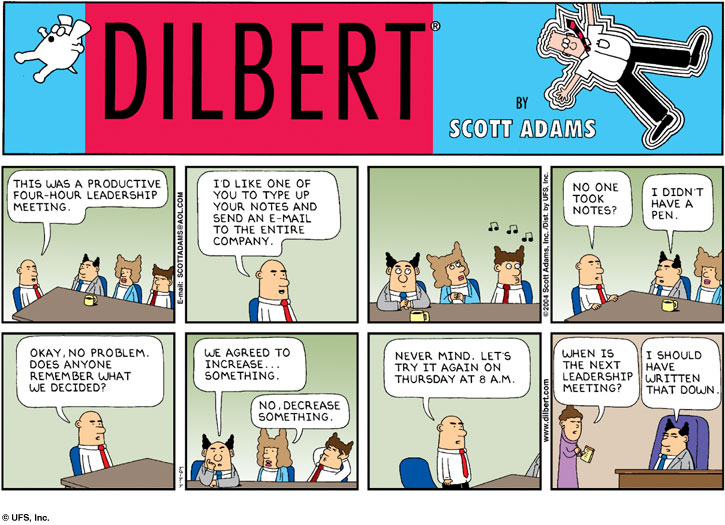Measuring the Cost and Value of Meetings: Part II – The Cost of People’s Time
 Example:
Example:
10 people with an average burdened rate of $100/hr attend a 1-hour meeting. The organization pays $1000 for those people to attend the meeting.
Why Most Companies Don’t Measure This Cost
This calculation quickly and easily shows the enormous sums an organization spends paying people to sit in meetings over the course of a typical month, but most organizations don’t bother running this calculation. Instead, they’ll spend hours (often expensive hours in meetings) strategizing on how to get the best deal on screen sharing.
Chalk that up to the power of the sunk cost fallacy. Ever heard the term “sunk cost”? Economists consider payments, investments or costs which can never be recovered sunk costs. When looking for ways to manage costs, managers and executives are trained to ignore money already spent in the past, which is gone and can never be recovered, and focus instead on how money can be spent going forward.
When it comes to tracking cost and value of meetings, managers will dismiss the cost of people’s time as one of these sunk costs because they’ve already committed to paying salaries.
The decision to spend salary dollars is in the past – done, over, and can’t be undone without major disruption to the organization. And here’s where that thinking fails: while you may have decided to spend salary dollars in the past, you’re actually spending them RIGHT NOW and every day going forward that you keep that person involved in your team.
Rather than a sunk cost, your team’s time should be viewed in terms of opportunity cost.
Opportunity Cost and Meetings
Opportunity cost examines the impact of any given choice. The term “opportunity cost” comes from the notion that every choice closes off an alternate choice, so if people waste their time and/or money on an unworthy activity, they can’t pursue more profitable opportunities.
Managers measure opportunity cost by putting a dollar value on a person’s time – multiplying the time someone spends by either their hourly cost (burdened rate) or their billable rate.
Calculating the cost of your people’s time spent in meetings tells you a lot about your organization’s focus and productivity, showing what percentage of your operational costs go to talking about work rather than producing work. Once you see this figure, you can ask the next question: how should you be spending that time and money?
If you want to minimize opportunity costs, you need to stop wasting time in bad meetings. Effective meetings include only those people required to achieve the meeting goal (reducing the number of people you’re paying to sit there) and stay focused (reducing the number of minutes spent in unproductive discussion).
Several studies show that organizations that receive training in basic effective meeting skills, such as preparing an agenda, monitoring time, and following up on meeting results, consistently yields significant time and cost savings.
Calculator A: Cost of People’s Time Spent in Meetings
So how much time and money are we talking about here?
At large companies, lots and lots of money. The 3M Meeting Management Team conservatively estimates that inefficient meetings involving middle managers within 3M corporation wasted $78.8 million annually.
Source: 3M Meeting Management Team, and Drew, J. Mastering meetings: discovering the hidden potential of effective business meetings.
To make it easy to see what the impact of holding more effective meetings could be for your team, try out this handy dandy calculator.
This simple calculator shows what you’re spending in people’s time on meetings now, and what the savings would be if you can shorten your meetings by 5 minutes, invite one fewer person, or simply hold one less meeting.
The studies referenced above show that all of these improvements are readily achievable by groups with access to effective meeting training and tools. Something as simple as a meeting timer, like the one included in Lucid Meetings, serves to focus the group discussion and drive it to a timely conclusion.
Calculator B: Total Meeting Costs Calculator
Do you enjoy playing with numbers? Then you’ll love this:
Behold the Total Meeting Costs Calculator. This beauty helps you see the cost savings you can gain by optimizing both the software costs and by implementing basic meeting best practices.
Number-loving friends, you’re welcome. For the rest of you, the conclusion is this: if you want to manage the costs associated with your team meetings, you should address your software costs, but the saving to be gained there pale in comparison to the gains made by improving the efficiency with which you run those meetings. Happy day for you – Lucid Meetings is designed to help you do just that.
Related Posts
You may also be interested in the other posts in this series about measuring the cost and value of meetings:
Image: wallpapermania.eu



